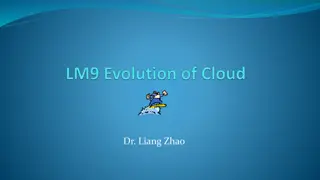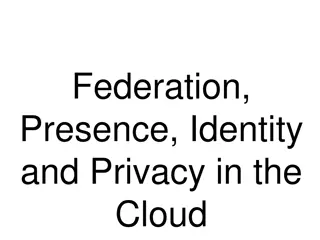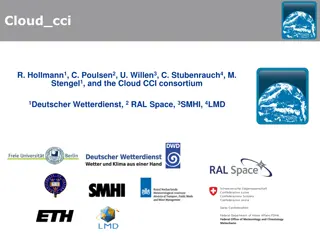The Dangers of Cloud Monocultures in Information Technology
Gene Spafford highlights the risks of consolidating critical information in the cloud, noting that the concentration of key resources creates a target for adversaries. Monocultures, where systems run identical software components, increase vulnerability to malware attacks. The example of OpenSSL's bug underscores the repercussions of widespread reliance on shared elements in the cloud community, emphasizing the need for diversification to mitigate security risks.
Download Presentation

Please find below an Image/Link to download the presentation.
The content on the website is provided AS IS for your information and personal use only. It may not be sold, licensed, or shared on other websites without obtaining consent from the author.If you encounter any issues during the download, it is possible that the publisher has removed the file from their server.
You are allowed to download the files provided on this website for personal or commercial use, subject to the condition that they are used lawfully. All files are the property of their respective owners.
The content on the website is provided AS IS for your information and personal use only. It may not be sold, licensed, or shared on other websites without obtaining consent from the author.
E N D
Presentation Transcript
CS5412 Sping 2015 1 CS5412: DANGERS OF CONSOLIDATION Lecture XXIII Ken Birman
Are Clouds Inherently Dangerous? 2 Gene Spafford, famous for warning that the emperor has no clothes fears that moving critical information to the cloud could be a catastrophe His concern? Concentration of key resources creates a treasure chest that adversaries can focus upon and attack Risk of a virus spreading like wildfire Core issue: Clouds create monocultures CS5412 Sping 2015
What Constitutes a Monoculture? 3 monoculture: An environment in which the predominance of systems run apparently identical software components for some or all services. Such systems share vulnerabilities, hence they are at risk to rapid spread of a virus or other malware vector. Cloned plants Cloned babies CS5412 Sping 2015
Forms of monocultures 4 Large numbers of instances of identical programs or services (includes applications, not just the O/S) Wide use of the same programming language or scripting tool Any standard defines a kind of monoculture CS5412 Sping 2015
Current example: OpenSSL 5 SSL (renamed Transport Layer Security: TLS) is a standard used to negotiate security keys for secure TCP communication Involves use of keys from certificate authorities to encrypt communication, including passwords Used for connections to https websites Issue: OpenSSL was an open source effort And open development: anonymous contributors One of those contributors introduced a bug in ~2012 CS5412 Sping 2015
What was the bug? 6 OpenSSL has a heart beat protocol If you are still there, send me XX bytes to prove it Normally XX was small, like 16, but the client could actually specify the value. Like 64. Or 128K With big values a buffer-read overrun caused OpenSSL to send back a snapshot of XX bytes of its memory YELLOW SUBMARINE And, in that memory area, one could sometimes find decrypted data including passwords CS5412 Sping 2015
Central lesson learned? 7 In the cloud community, majority solutions often dominate and become de-facto standards Everyone then uses them: They are presumed to be the best (because widely used), hence widely used... And if one of those shared elements is buggy, every system using them is at risk of compromise CS5412 Sping 2015
Taking the larger view 8 Three categories of attack Configuration attacks. Exploit aspects of the configuration. Vulnerability introduced by system administrator or user who installs software on the target. Includes compiling SNDMAIL with the back door enabled Technology attacks. Exploit programming or design errors in software running on the target. Vulnerability introduced by software builder. Here hacker breaks in via buggy code Trust attacks. Exploit assumptions made about the trustworthiness of a client or server. Vulnerability introduced by system or network architect. Hacker abuses legitimate access, like a hospital worker who peeks at Lindsey Lohan s medical records CS5412 Sping 2015
Monoculture: A defense for configuration attacks. 9 A carefully constructed, fixed, system configuration would be an effective defense against configuration attacks. System configuration (today) is hard to get right and thus is best done by experts. Having one or a small number of approved configurations would allow that. Configuration attacks are considered low hanging fruit and thus likely are the dominant form of attack today. Configurations change not only because a system administrator installs software but also from a user visiting web sites or interacting with web services that cause software downloads. To rule-out such downloads could be a serious limitation on system functionality. Such downloads often bring vulnerabilities, though. CS5412 Sping 2015
So monocultures help for one case 10 Question becomes: what percent of attacks leverage configuration mistakes? nobody knows! But gray-hat hackers assure us that things like standard passwords are a very common problem CS5412 Sping 2015
Viruses love monocultures 11 Earliest Internet Worm was launched at Cornell! A brief episode of notoriety for us Worm exploited variety of simple mechanisms to break into computer systems, then used them as a springboard to find other vulnerable systems and infect them It had a simple trick to prevent itself from reinfecting an already infected system: checked for a lock file But even if present, reinfected with a small probability Idea was to jump back onto systems that might have been fixed by system admin team but who left the lock in place CS5412 Sping 2015
Monocultures are a known risk 12 Vast majority of computer viruses and worms operate by exploiting software bugs For example, failure to check boundaries on arrays Very common in code written in C++ or C because those languages check automated boundary checks Nothing stops an input from overrunning the end of the array What lives beyond the end of an array? CS5412 Sping 2015
Beyond the end... 13 Two cases to consider Array is on the stack (local to some active method) Array is in the program s data or BSS area, or was allocated from the heap CS5412 Sping 2015
Stacks grow downwards... 14 registers, return PC locals foo(1, 2, 3) registers, return PC direction of stack growth Other locals Target array CS5412 Sping 2015
Stacks grow downwards... 15 registers, return PC locals foo(1, 2, 3) registers, return PC unreasonably long input string overwrites the locals and registers and the return PC Other locals Target array CS5412 Sping 2015
Stacks grow downwards... 16 registers, return PC locals foo(1, 2, 3) Attacker replaced the return PC with an address in the middle of the injected string PC points into data on the stack Compromised content includes virus code CS5412 Sping 2015
Why does this attack work? 17 Attacker needs to be able to predict Where the target string lives in memory How the stack is arranged What the code that reads the string will do Trick is to get the code to jump into the data read from the attacker CS5412 Sping 2015
Bootstrapping concept 18 The hacker doesn t have much room for instructions So typically this logic is very limited: often just code to read a longer string from the network and then execute that longer code In effect, the initial attack is a bootstrap program It loads and launches a more serious program CS5412 Sping 2015
Example 19 String loads code that simply allocates a much bigger object, reads from the same input source into it, and jumps to the start Allows the attacker to send a multi-GB program that would be way too large to fit within the stack Trick is to take over but not trigger exceptions If the attack causes the program to throw an exception, someone might notice CS5412 Sping 2015
What about data/heap? 20 Here attacker might be in a position to overwrite other adjacent variables on which the program is dependent This does assume some predictability in memory layout! We could perhaps replace a filename it reads or one it writes with filenames the attacker would prefer that it use instead, or with network URLs Of course the program will now be a very sick puppy but it might last just long enough to do the I/O for the attacker That I/O becomes a point of leverage that the attacker exploits like the first domino in a long line... CS5412 Sping 2015
Example attack opportunity 21 Any program that works with strings in C or C++ is at risk even if we length-check inputs void unsafe(char *a, char *b) { char tmp[32]; strcpy(tmp, a); strcat(tmp, b); return(strcmp(tmp, foobar )); } Problem here isn t with the input length per-se but with the assumption in unsafe that the combined string fits in tmp CS5412 Sping 2015
Why not just fix the compiler? 22 People have modified C to check array bounds This only helps in limited ways C and C++ and Fortran are unsafe by design because of pointer aliasing They let us treat an object of one type as if it was of some other type And they impose no real boundary checking at all Fixing the language would break many programs that are in wide use: we would need to fix them too CS5412 Sping 2015
Other examples of attacks 23 Back doors, such as debug or maintenance features Passwords left with their default values Automated file or patch download features that can be tricked into overwriting system files Code that has built-in features that can be misused to trick the program into executing unusual logic in fact the list is really endless! CS5412 Sping 2015
Broader problem 24 We simply don t have a good way to create things that are correct, by construction, ground up Lacking those, trying to find problems in existing code is like trying to plug a leak in a dam At best we can prove properties of one thing or another but the assemblage invariably has holes! Or they sneak in over time CS5412 Sping 2015
Cloud permissiveness 25 Anyhow, it makes no sense to imagine that we would tell people how to build cloud applications With EC2 we just hand Amazon an executable How will it know if the binaries were compiled using the right compiler? What if the version of the compiler matters? Generally not viewed as a realistic option In fact when C and C++ run on .NET many of these overflow issues are caught, but managed C or C++ will reject all sorts of classic programs as buggy CS5412 Sping 2015
How to attack a cloud 26 A good firewall can block many kinds of attacks But something will get through eventually, we can t avoid every possible risk and close every possible virus exploit And once the virus breaks in, it compromises every single accessible instance of the same code CS5412 Sping 2015
What can we do about these issues? 27 Today: Focus on these kinds of viral attacks Thursday: Look at the bigger picture CS5412 Sping 2015
First, lets stop the stack attack... 28 How can we do that? The attacker is taking advantage of knowledge of the program behavior and flaws An unpredictable program would have crashed but not been so easy to compromise Can we take a program written in C or C++ and make it behave less predictably without causing it to crash? CS5412 Sping 2015
Stack randomization 29 Idea is simple: Modify the runtime to randomly allocate chunks of memory (unpredictable size) between objects on stack We can also add a chunk of unpredictable size to the bottom of the stack itself Attacker countermeasures? May be possible to use a block of jump instructions, no- ops to create code that can run in a position independent manner Or might guess the offset and try, try again... If the datacenter doesn t notice the repeated crashes a few hundred tries might suffice to break in CS5412 Sping 2015
.NET has automated diversity 30 If enabled, a wide variety of randomization mechanisms will be employed Just a bit in the runtime environment you can set But important to retest programs with stack randomization enabled Some programs depend on bugs, other issues! CS5412 Sping 2015
More recent work on diversity 31 Diverse OS can scramble the number of system calls Placement of segments in memory can be varied Code can be dynamically relinked to reorder the placement of compiled code and data elements CS5412 Sping 2015
But this cant stop all attacks 32 For example, database code injection attacks have a similar approach and yet don t rely on array overflow: Intended code SELECT * FROM users WHERE name = '" + userName + "';" Limits query to data for this user Attacker sends a faulty name argument: ' or '1'='1 SELECT * FROM users WHERE name = ` or 1 =1; There are many examples of this kind because many programs exchange messages that involve application- specific programming languages CS5412 Sping 2015
Blocking SQL query injection? 33 This is easy: Read the input Then clean it up Then pass it in to the application As long as the developer uses the right tools these issues don t arise But not every developer cooperates CS5412 Sping 2015
Other ideas: Castro and Costa 34 One project at Microsoft monitors program crashes Each time a crash happens they look to see what input caused the program to fail In one project they create virus signatures In another they automatically combine these to create a pattern, more and more selective, for blocking the input strings that cause the problem Use gossip, rapidly and robustly disseminate the fix together with a proof of the bug that triggers it Manuel Costa, Jon Crowcroft, Miguel Castro, Antony Rowstron, Lidong Zhou, Lintao Zhang, and Paul Barham, Vigilante: End-to-End Containment of Internet Worms, in ACM Symposium on Operating Systems Principles (SOSP), Brighton, UK, Oct 2005 CS5412 Sping 2015
What kind of proof? 35 Before installing a patch, verify that problem is real Proof: Example of an input that will cause a crash or some other form of compromise Verification: Try it inside a virtual machine One issue: if the filter is too broad, it might block legitimate inputs that wouldn t cause a crash We want to block the attack but not legitimate users CS5412 Sping 2015
Back door attacks 36 Some attacks don t actually compromise a program For example, the early Internet worm operated by exploiting a feature in the original SNDMAIL program Code was written by Eric Allman and was unstable for the first few years So he needed ways to see what the problem was Included a debug feature allowing him to use SNDMAIL as a kind of remote FTP program to access files on remote system and SNDMAIL runs with elevated priority Internet worm used this feature as one of its attack vectors CS5412 Sping 2015
Stack diversity doesnt stop these 37 Backdoor attacks use legitimate features of a program, or perhaps debug features, to ask program to do things it was programmed to do! The program isn t really malfunctioning or compromised But it still does things for us that allow breakin For example, can use SNDMAIL to copy a modified program on top of /etc/init in Linux This modified program might work normally, but always allow logins from Evil.Hacker with password Gotcha Better compiler won t help CS5412 Sping 2015
Neither would better checking tools 38 A back door is a problem with the specification The program shouldn t have functionality that replaces arbitrary files with code downloaded from the network, or copied from other places, or even with code created within the program itself Yet it is very hard to pin down the rules we need to check to achieve confidence! CS5412 Sping 2015
The ultimate back door Who is this man? Do you trust his Software? Photo from http://culturadigitalbau.wikispaces.com/ file/view/thompson.c1997.102634882.lg.jpg/212982274/thompson.c1997.102634882.lg.jpg 39
The ultimate back door Ken Thompson Co-Creator of UNIX and C Turing Award: 1983 40
The ultimate back door 41 Ken Thompson discussed hidden back doors in a famous Turing Award lecture He considered the Unix login program Showed how a macro substitution could insert a back door Then pointed out that the macro preprocessor could have a back door that does the macro substitution Then he applied this to the macro preprocessor itself Ended up with a vanilla-looking Unix system that would always allow him to log in but where those lines of code could only be discovered by examining the byte code CS5412 Sping 2015
The ultimate back door 42 Compiler 011001001111010
The ultimate back door 43 Compiler ... if(program == login ) add-login-backdoor(); if(program == compiler ) add-compiler-backdoor(); 011001001111010
The ultimate back door Ken Thompson Co-Creator of UNIX and C Turing Award: 1983 44
The ultimate back door 45 In general, covert virtualized platforms lurk in many settings Virus could virtualize your machine Attacker with serious resources could sneak a monitoring component into your printer or the disk drive itself Even the network could potentially host a covert computing device and its own stealth network! Very hard to really secure modern computing systems. Cloud actually helps because many operators have resources to build their own specialized hardware CS5412 Sping 2015
Recent concern 46 Even common devices can have backdoors Line printers often have a wide variety of network APIs Network routers and firewalls The virtualization platforms that operate the cloud Web browsers We seem to be surrounded by insecure components CS5412 Sping 2015
What about virtualization as a tool? 47 By running the user s code in a virtual machine the cloud gives us a way to firewall the user from other users We share a machine but I can t see your work and you can t see mine Virtualization code needs to block things like putting the network into promiscuous mode ( monitoring mode) Forces us to trust the VM hypervisor and the hardware that supports virtualization, but gives containment Now a virus can only harm the user that let it in CS5412 Sping 2015
Other forms of diversity 48 Run different products that offer equivalent functionality, like two versions of an email server Strange finding: researchers have shown that for many applications, even versions created separately share bugs! Consider morphing the system calls: code would need to be compiled on a per-instance basis but would protect against attacks that require attacker to know local system call numbering Vary thread scheduling order dynamically CS5412 Sping 2015
Combining multiple methods 49 This is sometimes called defense in depth The first line of defense is the dynamically managed firewall: ideally, attack won t get in But if it does, randomization has some chance of defeating the attack one step later Each new obstacle is a hurdle for the attacker Will this stop attacks? Only simple ones... but most attacks use simple methods! CS5412 Sping 2015
Defense in depth 50 CS5412 Sping 2015























